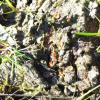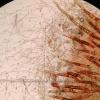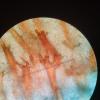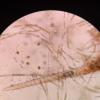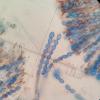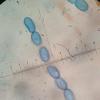
24-12-2025 17:08
Hulda Caroline HolteHello, I have found this propoloid ascomycete on

21-12-2025 09:32
Hello.A tiny ascomycete found embedded in wood in

21-12-2025 21:32
Pol DebaenstHello, Garden, Burgweg 19, Veurne, BelgiumOn 10/1

22-12-2025 23:38
Patrice TANCHAUDBonsoir, récolte sur un mur en pierre, apothéci

22-12-2025 00:47
Patrice TANCHAUDBonsoir, récolte à proximité du milieu dunaire
coprophilous Scutellinia
Warre Van Caenegem,
14-03-2025 23:29
Apothecia up to 5 mm
Hairs mostly bi- or trifurcated, sometimes simple, up to 600 µm, mostly between 300 and 500 µm, septated, the top of the hairs are hyaline,
Asci 205-240 x (12-)15-16 µm, 8-spored
Ascospores (16-)17-19(-20) x 10-12 µm, with regular spaced, low wrats
Found in Belgium, Antwerp, Mol, on 10 April 2024.
ITS has been sequenced, and matches 97,7% with Scutellinia sp. (Genbank Accession numbers MW540903.1 en MW540937.1), and 96,9% with S. fimicola (MW540964.1). The morphology does not match with S. fimicola, because of the smaller spores and the larger asci.
Are there any other fimicolous Scutellinia species known?
>Scutellinia_ITS
ACCCATCTGCGTACATTACCCGTTGCTTCCGCGAGGCAGTGATCTTCGATCACCTC
CCGACGATGGCTTGGGCCNTCCGGTGGGGAGCCCTCGTGAAAGGTTTACACCAA
ACCCTTGCATTTCTATGTCATCTGTCTGAAACTGTTAATAACAAATGTWAAAACTTT
CAACAACGGATCTCTTGGTTCTCGCATCGATGAAGAACGCAGCGAAATGCGATAA
GTAGTGTGAATTGCAGAATTCAGTGAATCATCGAATCTTTGAACGAACATTGCGCC
TCCTGGTATTCCGGGAGGCATGCCTGTTCGAGCGTCATTAATACCACACTCGAGT
CATTTTCGTGGCTCGGTCTTGGGAGAGGAGCGCAACTCGTCTGCCCTCCCTTCCG
AAATCCAATGGCGGAAAGCCCCACGTGCCCCGGCGTAGTAAGTCTTCTTTCGCTC
GGAACGTTTGGCGATCCTGCCGTGAACCCCCCACAAAATCATTTTACAGGTTGAC
CTCGGATCAGGTAGGGATACCCGCTGAACTTAAGCATA
Malcolm Greaves,
15-03-2025 10:04
Re : coprophilous Scutellinia
In the UK we have had at least 4 species which have been found on dung. Unfortunately none fit your specimen but it shows that at least some of the soil inhabiting species can also grow on dung.
Lothar Krieglsteiner,
15-03-2025 12:08

Re : coprophilous Scutellinia
my hyperborea/minor from the Alps that I want to re-examine soon was growing on cow dung, too.
I was surprised that it was definitely a Scutellinia and not a Cheilymenia.
I was surprised that it was definitely a Scutellinia and not a Cheilymenia.
